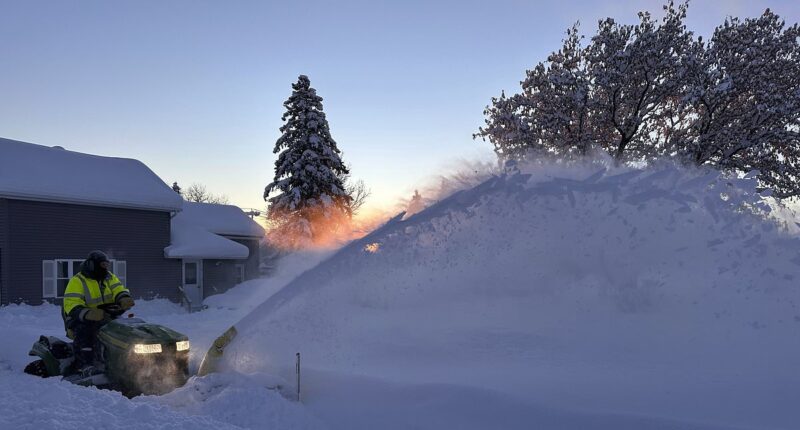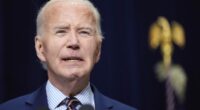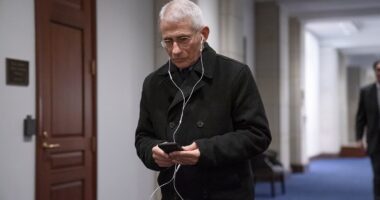
Tens of millions of Americans are under blizzard warnings as the country braces for the coldest storm since 2011, which is set to batter 30 central and eastern states.
The National Weather Service has warned that Storm Blair will bring freezing conditions across the country, from eastern Colorado to Massachusetts.
A state of emergency has already been declared in Kentucky, Virginia, Kansas, Arkansas and Missouri, where current temperatures below -10F are not usually seen.
Wind chills of -20F and even colder are forecast in Kansas, where the average low temperature for January is 21F, according to the National Oceanic and Atmospheric Administration (NOAA).
In Kentucky, temperatures are set to plummet to 2F, down from an average low of 26F, and in Virginia, where average lows are usually around 28F, the mercury is set to drop down to 13F.
Missouri is set to see temperatures of 3F, while in Arkansas it could get as cold as 21F.
Central states will be impacted on Sunday morning, with the storm bringing up to five inches of snow and 45mph winds to affected areas before moving east on Monday.
Meteorologists said a polar vortex spinning across from the North Pole via the jet stream is causing the intense dose of cold air to envelop the country.
A whopping 72 percent of flights out of Kansas City International had been canceled by 10am Sunday, where ‘rapid ice accumulation’ forced officials to close the airfield.
Even more travel chaos is expected on Sunday, with 1,176 flights delayed and 748 canceled across the US as of 10am, according to live tracking website FlightAware.
Meanwhile, icy weather has already sparked collisions on the roads, including in Kansas, according to state highway patrol trooper Ben Gardner.
Gardner posted a video on X showing a truck which had rolled over on the Interstate 135, while skidding across the ice himself to demonstrate the dangerous conditions.
Meanwhile, icy weather has already sparked collisions on the roads, including in Kansas, according to state highway patrol trooper Ben Gardner.
Close to Salina, Kansas, vehicles got caught in a major pile-up, with video footage from the area showing how the road resembled an ice rink.
Weather experts have warned against traveling ‘unless necessary’ in states where blizzard warnings are in effect.
The National Weather Service said travel ‘could be very difficult to impossible’, with snow whipped up by high winds creating a whiteout in the worst-hit areas.
The Kansas City Chiefs team were among those stranded at the airport for hours on Saturday ahead of their final regular season game against the Broncos.
Patrick Mahomes and Travis Kelce were among those seen walking off the plane in snowy Denver on Saturday night when their plane touched down four hours late.
Meteorologists said the snowfall this weekend could be the heaviest in a decade in areas which are accustomed to high snow totals.
Power outages are likely to strike areas which get more than a quarter-inch of ice. ‘It’s going to be a mess, a potential disaster,’ meteorologist Ryan Maue said.
Several businesses closed across the Kansas City area, and the school district in suburban Independence, Missouri, said it might need to cancel classes for one or more days.
‘Get where you’re going now and stay put. If you must travel, consider packing a bag and staying where you’re headed,’ the Missouri Department of Transportation said in a message on X.
AccuWeather Director of Forecast Operations Dan DePodwin said it could be the coldest January for the US as a whole since 2011, with a week or more of ‘temperatures that are well below historical average.’
The biggest temperature drop is forecast to hit the Ohio Valley, and unusually cold climes will extend to the Gulf Coast, with a hard freeze expected even in Florida.
‘The wind chills are going to be brutal,’ Woodwell Climate Research Institute climate scientist Jennifer Francis said. ‘Just because the globe is warming doesn´t mean these cold snaps are going away.’
In fact, the fast-warming Arctic may be spurring on the brutal cold as climate change sparks weather extremes, according to Judah Cohen from Atmospheric and Environmental Research.
The polar vortex – ultra-cold air spinning like a top – usually stays above the North Pole, but sometimes it stretches down to the U.S., Europe or Asia.
Cohen and others published a study last month attributing the increase in polar vortex stretching partly to changes from an Arctic that is warming four times faster than the rest of the globe.

















